Some types of tree fungus kill trees. Others ruin their aesthetic appeal by creating ugly tree marks and wounds. As a result, knowing how to identify and treat tree fungus can be critical to not only maintaining your tree’s value but also saving its life.
A tree fungus can be identified depending on which part of the tree it attacks, the species of tree it’s on, the shape, and its color. In most cases, tree removal, treatment with an antifungal, and cutting off infected regions, are common treatment options for tree fungal infections.
Here is what you should know about the identification and treatment of tree fungus.
What we cover
ToggleCommon Tree Fungus Identification
You can identify fungus depending on its appearance. The effect that it has on a tree and how it eventually spreads can be a pointer as to what type of fungus you are dealing with.
Here are the most common types of tree fungi and how you can easily identify them.
Oak wilt
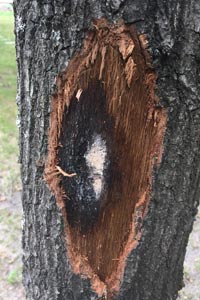
This tree fungus that tends to specialize in oaks is caused by Ceratocystis fagacearum. This is a fungus that is transferred from one oak to the next by insects. Contact between root systems is also a common method of transfer.
Symptoms
It is a dangerous disease that can easily kill an oak tree. And once it infects an oak tree, you are bound to notice discolored leaves, defoliation, and wilting. The tree also tends to die from the top down.
Targets
And while the fungus targets all oak species, red oaks tend to be the most vulnerable to an attack.
Dutch elm disease
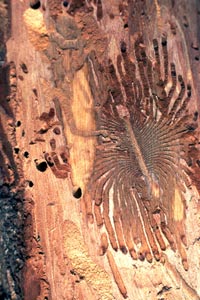
The Dutch elm disease is a serious fungus that mainly targets elms. The elm bark beetle spreads it, and it can be deadly for elms.
Symptoms
Common symptoms of this wilt disease include yellowing, wilting, and curling leaves. the tree will also shed its leaves prematurely. And if left untreated, tree death is possible.
Targets
The main target of this fungus is elm trees.
Verticillium Maple wilt
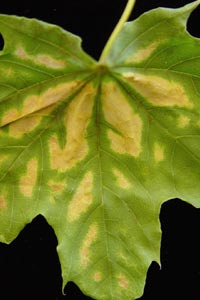
This tree fungus that affects a tree’s vascular system is caused by Verticillium dahliae and Verticillium albo-atrum. It typically starts its attack at the root level and gradually spreads throughout the tree’s food transport system. Eventually, it blocks the transportation system.
Symptoms
The blockage that the fungus invasion causes typically leads to a number of symptoms. This includes stunted growth, yellowing foliage, and leaves that curl and dry out. And these symptoms usually appear on one side of the tree.
Targets
Common targets of this tree fungus include oaks, maples, magnolias, dogwoods, cherries, ash trees, azalea, and redbud trees.
Oak root fungus
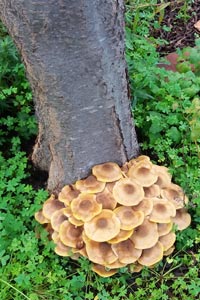
This type of fungus is usually referred to as armillaria root rot because of the fungus that causes it.
Symptoms
It is notorious for causing wilting, dulling, and yellowing of leaves. It also causes trees to lose vigor and sometimes also causes their leaves to turn brown. And if left to advance, it can compromise a tree’s structural integrity to a point of causing to fall.
Targets
And while it is usually referred to as oak root fungus, it targets more than oak trees. In fact, most shrubs and trees typically fall victim to this tree fungus.
Phytophthora root rot
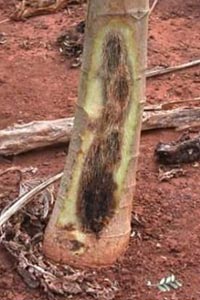
This is another root rot fungus that targets the root systems of trees that it attacks. It is dangerous in that it can completely kill a tree. And even if it doesn’t, if it becomes advanced enough, it will weaken a tree to the point of making it fall.
Symptoms
Typically, this tree fungus causes the browning or yellowing of leaves. It has a habit of also making them undersized. This includes suppressing the overall growth of the trees. And in most cases, trees with Phytophthora root rot tend to have curled or droopy leaves.
Targets
Trees that are most susceptible to phytophthora root rot include aucuba, mountain laurel, dogwoods, azalea, shortleaf pine, heather, deodar cedar, Pieris, Fraser fir, juniper, and yew bushes. However, it tends to affect an incredibly large array of plants.
Thousands canker disease
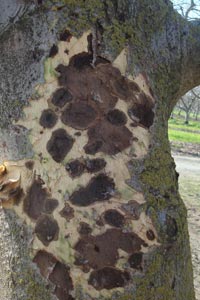
This is a type of canker disease that is caused by Geosmithia morbida. It is normally spread by beetles. And while it causes cankers, the cankers that it causes are rarely visible. This is because they are typically located under a tree’s bark.
Symptoms
The obvious sign that a tree has been infected with this disease is the existence of small and discolored leaves. Canopy thinning and dieback of individual branches are also common symptoms.
Targets
Black walnuts are the most susceptible to this type of fungus. However, other species of walnuts are not immune to it.
Bleeding cankers
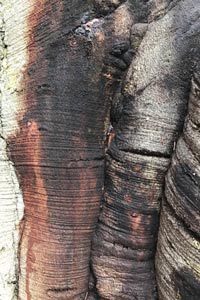
Phytophthora fungi are the ones that cause bleeding cankers.
This tree fungus usually presents as an oozing fluid that is typically reddish-brown. And it typically has the effect of strangling a tree’s vascular system to a point where the tree can’t efficiently transport its resources.
Symptoms
The most obvious symptom of bleeding cankers is an oozing fluid that is normally reddish-brown in color. A strong fermenting odor is also likely to come from the infected spot.
A tree that has been infected with this fungus will tend to feature cases of branch dieback. This may also be accompanied by sparse and pale foliage.
Targets
The most common targets for bleeding cankers include oaks, maples, and beech trees.
Cytospora canker
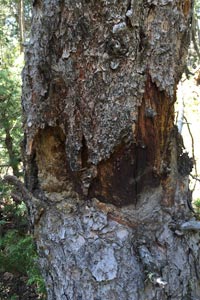
This type of tree fungus typically targets spruce trees. And once it infects the tree, it usually kills a portion of the tree in the area in which it grows. This growth is typically located on the inner bark of the tree.
Symptoms
While the cankers that are caused by this tree fungus are rarely visible, graying needles is a common symptom. And so is the upward dying of branches.
Targets
The most popular targets for this canker fungus include the Norway spruce, Colorado blue spruce, Douglas fire, white spruce, and Koster’s blue spruce. However, generally, provided it is a spruce, then it is vulnerable to this type of tree fungus.
Hypoxylon canker
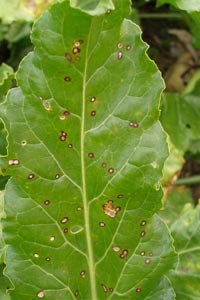
This is a type of fungus that specializes in attacking injured or stressed-out hardwoods. Generally, it affects a tree by messing with its growth. And it can even lead to a tree’s death.
Symptoms
The main symptom of this canker is tan or light brown growths that eventually assume a silver-gray look with random black spots.
Targets
The hypoxylon canker mainly targets sycamores, aspens, and oaks.
Cercospora leaf spot

This is a fungus that attacks leaves. It is typically characterized by gradually increasing leaf spots. Eventually, they end up interfering with a tree’s food-producing capacity.
Symptoms
The main symptom of Cercospora leaf spots is tiny black flecks that are surrounded by round leaf spots. The borders of these spots can be either dark brown or purple.
Targets
White oaks are a major target of this tree fungus. Shade trees and ornamentals are also common targets.
Anthracnose
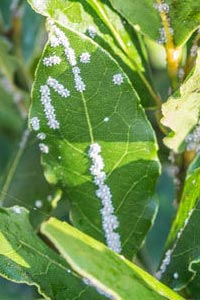
Anthracnose is another fungus that typically attacks a tree’s leaves. It prefers to attack in Spring and tends to leave a tree stressed out and vulnerable to other infections.
Symptoms
Leaf blotches, wilting, purple-ringed brown leaf spots, dieback, and defoliation are common symptoms of this tree fungus.
Targets
The trees that are most susceptible to attacks by anthracnose include maples, hickory, tulips, walnuts, birch, sycamores, ash trees, dogwoods, and oaks.
Sooty mold

Sooty mold usually attacks insect-infested trees. This is because it normally grows on honeydew. And as a result, it is notorious for causing the leaves of trees that it attacks to run black. Consequently, it usually has the effect of hampering a tree’s food-producing ability.
Symptoms
The main symptom of this tree fungus is blackening leaves.
Targets
And it typically targets fruit trees, willows, maples, elms, oaks, ash trees, and rose plants.
Powdery mildew
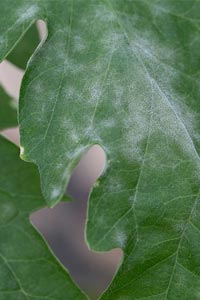
Like sooty mold, powdery mildew also coats the leaves of trees or plants that it attacks. Both of them have the effect of interfering with the photosynthesis process. And the main difference between the two is the fact that powdery mildew tends to be white in color.
Symptoms
The main sign that a tree has been attacked by powdery mildew is the presence of white patches on its leaves. Their growth almost resembles talcum powder.
And since it affects the ability of a tree to produce food, it also tends to cause stunted growth.
Targets
The types of trees that are most vulnerable to this tree fungus include dogwoods, peonies, crape myrtles, and lilacs. However, it can still attack a variety of other plant species.
Why does tree fungus grow?
Tree fungus grows when its spores land on a tree that is vulnerable enough to encourage its growth. This may be a tree with fresh wounds, a dying tree, or a tree that is stressed out as a result of physical trauma or lack of resources.
And since some tree species are naturally vulnerable to some fungus types, their spores landing on the vulnerable tree species is sometimes enough to encourage growth. This is irrespective of whether the tree is stressed out, injured, or dying.
How do you get rid of tree fungus?
Getting rid of a tree fungus is a 3 step process.
It starts off with you sterilizing your cutting tools. Dipping them in a bucket full of diluted bleach is usually enough to do the trick.
The next step is to cut off any tree limbs that have been severely affected by the fungus. And after you are done, make sure that you dispose of them.
With the severely affected limbs removed, the next step is to simply spray the tree with a good fungicidal spray. You can buy a ready-to-use spray, or you can opt for one where you have to mix yourself.
Soaking the tree with such a spray will be enough to kill off any fungi that you haven’t removed. This is something that you may have to do on a regular basis in order to keep the tree fungus-free.
Can a tree with fungus be saved?
Yes, a tree with a fungus can be saved.
It can be saved by spraying it with a fungus-killing solution. And if the infection hasn’t spread to the whole tree, cutting off the infected limbs can work.
However, there are some fungus types that do not respond to fungicides. In some cases, lopping off infected limbs may not even work. For these types of tree fungi, removing the tree is usually the best option.
Symptoms of tree fungus
Sometimes, early detection is essential to being able to save a tree from the clutches of a dangerous fungus. This makes learning about the signs of a fungus critical to being able to appropriately treat an infected tree.
The following are the most common signs that a tree has been attacked by a fungus.
- Rust, which may be stem rust or leaf rust
- The presence of a white moldy substance
- The existence of a powdery substance
- Tree leaves that are turning yellow
- The presence of brown spots on a tree’s leaves
- The presence of tar-like spots especially in sycamores and maples
- Predominant blisters on leaves
Treatment for fungus
Treating a fungus starts with conducting a tree inspection. This inspection will help to identify the type of fungus that is affecting the tree. It will also help to identify the best course of treatment.
After identifying the fungus, the next step is to remove infected branches, leaves, or twigs. A pair of shears, a chainsaw, and any other pruning equipment will come in handy in helping you to do so.
Thereafter, containing and removing the fungus with a good fungicide follows. Simply follow the instructions of manufacturers in terms of how to prepare the solution and when to apply it.
The last step is then to help the tree regain its health. This helps because trees naturally have strong immune systems that can discourage the growth and development of fungi. Watering the tree, fertilizing it, and appropriately pruning it usually helps.




